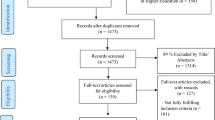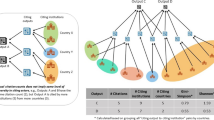Abstract
In 1998, the Australian federal government published comprehensive performance indicator data on universities. This article makes use of several indicators to examine correlates of research productivity in Australian universities, and to test the explanatory power of Marginson's (1997) typology of universities. Research productivity is measured using the quantity known as the 'research quantum' (RQ), which is a performance-related component of operating grant funding. Results of the analysis reveal that a large proportion of the variability in research performance can be attributed to two latent constructs. One relates together favourable student-staff ratios, a high proportion of graduating students continuing into further study, and a high proportion of research qualified staff. The other connects graduates' experiences of low quality courses, good student progress rates and low attrition with high graduate employability. These factors also predict membership of the four Marginson types. The results confirm that Australian universities can be separated into four main reputational groups based chiefly on research performance. Some implications for the use of performance indicators in a more market-driven system are discussed.
Similar content being viewed by others
References
Australian Research Council (1997). Submission to the Review of Higher Education Financing and Policy (www.deet.gov.au/divisions/hed/hereview/submissions/I/ic_a6.htm).
Blackburn, R.T., Behymer, C.E. and Hall, D.E. (1978). 'Research note: Correlates of faculty publications', Sociology of Education51, 132–141.
Bland, C.J. and Ruffin, M.T. (1992). 'Characteristics of a productive research environment: Literature review', Academic Medicine67(6), 385–397
Bourke, P. (1997). Evaluating University Research: The British Research Assessment Exercise and Australian Practice. Australian Research Council and Higher Education Council. Commissioned Report No. 56. Canberra: AGPS.
Creswell, J.H. (1985). Faculty Research Performance: Lessons from the Sciences and Social Sciences. ASHE-ERIC Higher Education Report No. 7. Washington, D.C.: Association for the Study of Higher Education.
Department of Employment, Education, Training and Youth Affairs (1997). The Composite Index: Allocation of the Research Quantum to Australian Universities. Canberra: Research Branch, Higher Education Division, DEETYA.
Department of Employment, Education, Training and Youth Affairs (1998). Characteristics and Performance of Higher Education Institutions (A Preliminary Investigation). Canberra: Research Branch, Higher Education Division, DEETYA.
Fox, M.F. (1983). 'Publication productivity among scientists: A critical review', Social Studies of Science13, 285–305.
Fox, M.F. (1992a). 'Research, teaching, and publication productivity: Mutuality versus competition in academia', Sociology of Education65, 293–305.
Fox, M.F. (1992b). 'Research productivity and environmental context', in Whiston, T.G. and Geiger, R.L. (eds.), Research and Higher Education. Buckingham: SRHE and Open University Press.
Hattie, J. and Marsh, H.W. (1996). 'The relationship between research and teaching-A metanalysis', Review of Educational Research66, 507–542.
Hilmer, F, (1993). National Competition Policy: Report by the Independent Committee of Inquiry. Canberra: AGPS.
Leslie, L. (1993). 'Commercialisation of science in Australian universities', Draft paper, Center for the Study of Higher Education, University of Arizona, Tucson.
Long, J.S. (1978). 'Productivity and academic position in the scientific career', American Sociological Review43, 889–908.
Lotka, A.J. (1926). 'The frequency distribution of scientific productivity', Journal of the Washington Academy of Sciences16, 317.
Marginson, S. (1997). 'Competition and contestability in Australian higher education, 1987–1997', Australian Universities' Review40(1), 5–14.
Ramsden, P. and Moses, I. (1992). 'Associations between research and teaching in Australian higher education', Higher Education23, 273–295.
Ramsden, P. (1994). 'Describing and explaining research productivity', Higher Education27, 207–226.
SPSS (1995). Statistical Package for the Social Sciences, Release 6.1.1 for Power Macintosh. SPSS Inc.
West, R. (1998). Learning for Life. Review of Higher Education Financing and Policy, Final Report. Canberra: AGPS.
Wilson, K., Lizzio, A. and Ramsden, P. (1997). 'The development, validation and application of the Course Experience Questionnaire', Studies in Higher Education22, 33–53.
Author information
Authors and Affiliations
Rights and permissions
About this article
Cite this article
Ramsden, P. Predicting institutional research performance from published indicators: A test of a classification of Australian university types. Higher Education 37, 341–358 (1999). https://doi.org/10.1023/A:1003692220956
Issue Date:
DOI: https://doi.org/10.1023/A:1003692220956




